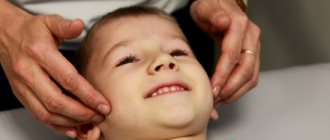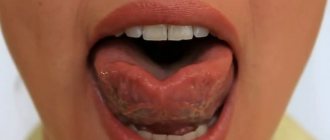Sigmatism is a deficiency in the pronunciation of hissing ([Zh], [Sh], [H], [Sh]) and whistling ([S-S′], [Z-Z′], [C]) phonemes. Both groups belong to the sounds of late ontogenesis, while hissing ones are considered articulatory more complex than whistling ones. Among speech sound defects, various variants of sigmatism are more common than other distortions. In older preschool children with dyslalia, whistling sigmatism is detected in 22% of cases, sibilant sigmatism - in 24%, in children with erased dysarthria - in 95% and 82%, respectively. Often, defective sound pronunciation persists in adults.
Causes of sigmatism
Sigmatism as a short-term phenomenon can occur in children during the period of physiological change of teeth. When baby teeth fall out, the tip of the tongue sometimes occupies an interdental position, which gives speech a lisping tone. Typically, children quickly find compensatory articulation that promotes normative pronunciation, and the problem soon disappears. Persistent pathological sigmatism has the following causes:
- Dentofacial anomalies.
Prognathia can lead to labiodental sigmatism. The cause of interdental pronunciation of sounds is usually an anterior open bite, a narrow and high hard palate, and a shortened frenulum of the tongue. Nasal pronunciation is typical for cleft palates. - Violation of the innervation of the organs of articulation.
Leads to changes in the tone of the tongue, laxity of the soft palate, paresis or increased spasticity of the lips. With innervation inferiority, interdental or lateral sigmatism most often occurs. - Diseases of the ENT organs.
Difficulty in nasal breathing caused by adenoids, vasomotor or allergic rhinitis causes the child’s mouth to constantly remain slightly open. In this case, the tip of the tongue ends up in an interdental position - interdental sigmatism is formed. - Incorrect articulation patterns.
There is no organic pathology on the part of the articulatory organs. The immaturity of articulatory praxis comes to the fore. This situation can occur in somatically weakened children when imitating incorrect speech patterns. - Hearing loss.
A decrease in physical hearing usually leads to sound substitutions - parasigmatism; less often, with hearing loss, distorted pronunciation of sounds is observed. It is caused by unclear auditory differentiation of correctly and incorrectly pronounced phonemes.
In practical speech therapy, sigmatism occurs in a number of speech disorders: various forms of dyslalia and dysarthria, alalia, rhinolalia, ONR, FFN. A lisp may occur in children with intellectual disabilities.
Staging from other sounds
The correct pronunciation of “s” can be formed from other sounds. In this case we will talk about the sounds “ts” and “sh”. Initially, the child should reproduce “sh” in a drawn-out manner. Then the tongue gradually moves towards the teeth, without leaving the palate. "Sh" will gradually transform into a fuzzy whistling sound. To get a “s” out of it, you need to clench your teeth. After this, the child must repeat the attempt to replace one sound with another.
The production of whistling consonant sounds from “ts” is less common. The essence of the method is the drawn-out pronunciation of the sound “ts”. The child will not have to change the position of the tongue. The sound is automatically transformed into “s”. After this, it is recommended to consolidate the result with the help of tongue twisters or poems.
Phonetic characteristics of whistling and hissing sounds
Whistling [S], [Z] and hissing [Sh], [Zh], [Sh] - consonants, oral, anterior lingual, fricative. Of these, [Z] and [Zh] are voiced (during phonation, the vocal folds vibrate, producing a voice), the rest are voiceless. Whistling [C] and hissing [Ch] differ only in the method of formation - they are occlusive-fissional. [H] and [Sh] are always soft, [C], [Sh], [F] are always hard, [S], [Z] - have soft pairs [S′] and [Z′]. An important difference between the group of whistlers and hissers is the basic articulatory structure, including:
- position of the lips: when pronouncing sibilants, the lips are stretched in a smile, when pronouncing hissing ones, they are rounded and slightly extended forward;
- position and shape of the tongue: when articulating sibilants, the tongue is located “mound” behind the lower incisors, when articulating sibilants - at the alveoli in the shape of a “cup”;
- characteristics of the air stream: for those who whistle, it is narrow and cold; for the sizzling ones, it is wide and warm.
A set of articulation exercises
Differentiation of whistling patients is based on the performance of exercises that the speech therapist selects individually. Among the most effective are the following:
- It is necessary to open your mouth wide in a smile without closing your teeth. After a few seconds, you can relax your lip muscles. The exercise is repeated 5-6 times.
- The starting position is the same as in the previous exercise. You need to run the tip of your tongue along the gums, simulating brushing. First, attention is paid to the upper teeth, then to the lower teeth.
- The mouth stretches into a smile, after which the tip of the tongue should touch the corners of the lips one by one. The chin should be motionless at this moment.
- The tongue protrudes as much as possible. First, it must be pulled to the tip of the nose, and then to the chin. After this, you should alternately touch the wide side of your tongue to your lips.
- With your teeth completely closed, you should stretch your lips into a tube as much as possible. The exercise is repeated 5 times.
Types of sigmatism
All forms of sigmatism are divided into two large groups: hissing sigmatism and whistling sigmatism. The methods for correcting defective sound pronunciation depend on the nature of the distortion of sounds. The main types of sigmatism in both groups of sounds are identical:
- Interdental.
The tip of the tongue takes a position between the upper and lower incisors. Phonemes acquire a lisping sound. - Prizubny.
The tongue rests against the edges of the incisors, blocking the passage of air through the interdental gap. The sound produced is acoustically close to [T]. - Labial-dental.
The lower lip comes closer to the upper teeth, the air comes out in a jerky manner. Instead of the correct sound, a distorted [F] or [V] is heard. - Side.
The exhaled air stream exits through a one-sided slit or along both lateral edges of the tongue. The sound is noisy and squelching. - Nasal.
During phonation, air does not come out through the mouth, but through the nasal cavity. Because of this, the sound has a snoring sound with a nasal tint.
In addition, hissing [Sh], [Zh] may have other types of distortion that are characteristic only of them:
- lower
- the tongue is lowered behind the lower incisors, hissing sounds are pronounced softly; - buccal
- the air stream goes into the cheeks, causing them to swell, instead of sound a noise is heard; - posterior lingual
- air passes between the hard palate and the back of the back of the tongue, a “hunting” or “whooping” is heard, reminiscent of the southern Russian dialect.
Preparatory activities
Before performing exercises aimed at developing conversational speech, breathing training is carried out.
She teaches how to blow a stream of air from the lungs. To make the training more interesting for the child, it is recommended to use a small cotton wool or ball. The most common exercises that develop breathing include the following tasks:
- It is necessary to prepare an empty small bottle. Its neck should be brought to the lower lip. A stream of air is directed into the bubble. If the baby does everything correctly, a characteristic sound appears. This exercise is called “storm”.
- The palms need to be placed on the stomach. Then a deep breath is taken through the nose, after which the breath is held for a couple of seconds. Exit is through the mouth. The purpose of the exercise is to teach the child to control the air stream. The task is called "accordion".
- The “breeze” exercise is performed by stretching out the lips with a tube. A deep breath is taken through the nose. Then a palm is placed to the lips, and a stream of air is released through the mouth.
Diagnostics
To identify sigmatism, determine its form and causes, a speech therapy examination is carried out. It is also important to understand which speech disorder is manifested by sound distortion. During the diagnosis, the speech therapist examines the medical and speech history, then proceeds to an objective examination:
- Articulatory organs.
The oral organs are examined, the tone of the facial and articulatory muscles, and the state of oral praxis are assessed. If anomalies of the maxillofacial area or muscle tone disorders are detected, a preliminary speech diagnosis is established. If necessary, a referral to a consultation with an orthodontist or neurologist is issued. - Speech hearing.
The differentiation of sounds is checked when they are pronounced in isolation, in syllables, words, phrases. For this purpose, special picture and speech material is used that corresponds to the age and intelligence of the speech pathologist. Special didactic techniques are used to distinguish between different types of sigmatism and parasigmatism. - States of sound pronunciation.
It is carried out to identify all defects in sound pronunciation (both phonetic and phonemic), the number of disturbed sounds. With hissing and whistling defects, the type of sigmatism is established. After this, the sequence of correction work is determined.
If a child is suspected of having a systemic speech disorder, examination of the lexical and grammatical aspects of speech is mandatory. If hearing loss is suspected, it is advisable to refer the patient to an otolaryngologist to check the state of hearing function.
Exercise “Calyx” - basic for making hissing sounds
Correction
Health care
Special treatment is required to eliminate factors predisposing to sigmatism. Bite correction may include various types of orthodontic care: wearing braces, special mouth guards, and devices of various types. If necessary, orthognathic intervention is performed. The choice in favor of surgical tactics for a shortened frenulum is made if it is impossible to stretch the ligament using speech therapy methods.
In case of disturbances in the innervation of the articulatory muscles, all speech therapy work is carried out against the background of drug treatment and physiotherapy prescribed by a neurologist. The lack of free nasal breathing, as a cause of sigmatism, requires appropriate treatment: removal of the adenoids, antiallergic therapy.
Speech therapy correction
Speech therapy work to eliminate all forms of sigmatism is subject to a single algorithm. It includes three periods during which certain corrective tasks are solved:
- Preparatory.
At this stage, the necessary articulation patterns are formed: the correct position of the lips and tongue. Work is underway to develop the strength and direction of the air stream. Support sounds are practiced ([I], [F] - for [S], [T], [S] - for [Sh]. Methods by which the objectives are achieved include articulation and breathing exercises, and, if indicated, speech therapy massage . - Sound production.
It is carried out in different ways: by imitation (“how a pump whistles”, “like a mosquito rings”, “like a snake hisses”), using articulation exercises or with the help of instruments (probe substitutes, probes). The basic sound for all whistling sounds is [S], and for other hissing sounds - [Ш]. - Automation.
Having achieved the correct pronunciation of an isolated sound, they move on to consolidating it, sequentially introducing syllables (direct, reverse, with a combination of consonants), words, phrases and spontaneous speech. After practicing hard sounds, they begin to assimilate their soft pairs. There is no differentiation stage for sigmatism and other sound distortions.
The traditional sequence of production of sounds is determined by the timing of their appearance in ontogenesis. If both groups are violated, the sound production of whistling sounds is carried out first, then hissing sounds (an exception may be dysarthria, when the sounds are placed in the reverse order).
If sigmatism is part of a complex speech defect, then work is carried out in parallel on other aspects of speech: syllable structure, vocabulary, grammar, prosody, etc. The time frame for correcting sigmatism may vary for different children; the period of speech therapy work takes up to 45-90 days or more.
Note to parents
The sounds “ts”, “s”, “sh” can be made at home. In this case, responsibility for the outcome of the training falls on the shoulders of the parents. The following principles must be kept in mind:
- The load on the speech apparatus increases gradually. Otherwise, the baby will not be able to learn new information.
- During the exercises, it is recommended to make associations with the world of animals and insects. The sounds “s” and “z” are compared to the squeaking of a mosquito.
- It is necessary to allow the child to independently find a comfortable position for the organs of articulation to reproduce insulating sounds.
- If your child does the exercises without enthusiasm, it is better to stop exercising. This indicates that he is tired.
- Classes must be regular. The optimal frequency is 2-3 times a week. The duration depends on the nature of the baby’s speech deviation.
- When performing mechanical production of sound pronunciation, objects that are not dangerous to the child should be used. It is desirable that this be a special speech therapy probe.







